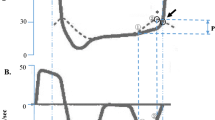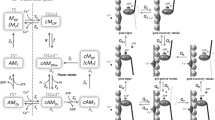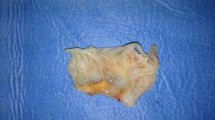Abstract
The mechanical properties of myocardium of different animals are modified by a chronic increase in haemodynamic load. In this study differences in calcium sensitivity and maximum unloaded shortening velocity of hypertrophic and non-hypertrophic chemically skinned human atrial fibres are characterized. Investigating right atria of 34 patients, possible correlations are studied between preoperative atrial pressure, degree of hypertrophy (estimated from the muscle fibre diameter), calcium responsiveness (pCa50 eliciting half-maximum contraction) and V max (unloaded shortening velocity). Hypertrophic fibres from atrial appendages of patients having an increased right atrial pressure (RAP 8.5±1.6 mm Hg) and suffering from mitral valve disease (stenosis and insufficiency combined) had a fibre diameter of 18.0±0.9 μm. They also had a higher calcium sensitivity (pCa50 5.65±0.08) and a lower unloaded shortening velocity (1.7±0.1 muscle lengths/s) than non-hypertrophic fibres from the appendages of patients with normal right atrial pressure (RAP 3.2±0.5 mm Hg) and coronary heart disease (CHD: pCa50 5.45±0.04; V max= 3.4±0.2 muscle lengths/s; fibre diameter 12.8±0.4 μm). Thus non-hypertrophic fibres from control CHD patients differed significantly (p < 0.01) from hypertrophied atrial fibres of patients with mitral valve disease and with combined valve disease (MAV, pCa50=5.58±0.05, V max 2.0±0.3 muscle lengths/s, fibre diameter 14.6±0.9 μm) or aortic valve disease (stenosis combined with insufficiency, fibre diameter 14.8±1.4 μm, pCa50 5.56±0.03, V max 2.0±0.24 muscle lengths/s; RAP 11.0±2.6 mm Hg). Such alterations of calcium responsiveness, shortening velocity and fibre thickness may reflect an adaptation to the chronic overload in atria from patients with various forms of heart valve disease.
Similar content being viewed by others
References
Arndt H, Katus HA, Mall G, Rüegg JC (1987) Different calcium sensitivity and mechanical properties of skinned fibres from hypertrophic and non-hypertrophic human atria. J Muscle Res Cell Motil 8:75
Bouvagnet P, Leger J, Dechesne C, Dureau G, Anoal M, Leger JJ (1985) Local changes in myosin types in diseased human atrial myocardium: a quantitative immunofluorescence study. Circulation 72:272–279
Brenner B (1988) Effect of Ca2+ on cross-bridge turnover kinetics in skinned single rabbit psoas fibers. Proc Natl Acad Sci USA 85:3265–3269
Cummins P (1982) Transition in human atrial and ventricular myosin light chain isoenzymes in response to cardiac pressure overload-induced hypertrophy. Biochem J 205:195–204
Ebrecht G, Rupp H, Jacob R (1982) Alterations of mechanical parameters in chemically skinned preparations of rat myocardium as a function of isoenzyme pattern of myosin. Basic Res Cardiol 77:220–234
Edman KAP (1978) Maximum velocity of shortening in relation to sarcomere length and degree of activation of frog muscle fibres. J Physiol (Lond) 278:9–10
Fabiato A, Fabiato F (1979) Calculator programs for comparing the composition of the solutions containing multiple metals and ligands used for experiments in skinned muscle cells. J Physiol 75:463–505
Ferenczi MA, Simmons RM, Sleep JA (1982) General considerations of cross-bridge models in relation to the dependence on Mg ATP concentration of mechanical parameters of skinned fibres from frog muscle. In: Twarog BM, Levine RJC, Dewey PP (eds) Basic biology of muscles: a comparative approach. Raven Press, New York, pp 91–107
Ferenczi MA, Goldman YE, Simmons RM (1984) The dependence of force and shortening velocity on substrate concentration in skinned muscle fibres from Rana temporaria. J Physiol (Lond) 350:519–543
Gorza L, Pauletto P, Pessina AL, Sartore S, Schiaffino S (1981) Isomyosin distribution in normal and pressure overload rat ventricular myocardium. An immunohistochemical study. Circ Res 49:1003–1009
Gorza L, Mercadier JJ, Schwartz E, Thornell LE, Sartore S, Schiaffino S (1984) Myosin types in the human heart. An immunofluorescence study of normal and hypertrophied atrial and ventricular myocardium. Circ Res 54:694–702
Hibberd MG, Jewell BR (1982) Calcium- and length-dependent force production in rat ventricular muscle. J Physiol (Lond) 329:527–540
Hirzel HO, Tuchschmid CR, Schneider J, Krayenbuehl HP, Schaub MC (1985) Relationship between myosin isoenzyme composition, hemodynamics, and myocardial structure in various forms of human cardiac hypertrophy. Circ Res 57:729–740
Lompre AM, Schwartz K, D'Albis A, Lacombe G, VanThiem N, Swynghedauw B (1979) Myosin isoenzyme redistribution in chronic heart overload. Nature 282:105–107
Mall G, Schwarz F, Derks F (1982) Clinicopathologic correlations in congestive cardiomyopathy. Virchows Arch [A] 397:67–82
Mercadier JJ, Lompre AM, Wisnewsky C, Samuel JL, Perovici J, Swynghedauw B, Schwartz K (1981) Myosin isoenzymic changes in several models of rat cardiac hypertrophy. Circ Res 49:525–532
Mercadier JJ, Bouveret P, Gorza L, Schiaffino S, Clark WA, Zak R, Swynghedauw B, Schwartz K (1983) Myosin isoenzymes in normal and hypertrophied human ventricular myocardium. Circ Res 53:52–62
Mercadier JJ, de la Bastie D, Menasche P, N'Guyen VanCao A, Bouveret P, Lorente P, Piwniea A, Slama R, Schwartz K (1987) Alpha-myosin heavy chain isoform and atrial size in patients with various types of mitral valve dysfunction: a quantitative study. J Am Cell Cardiol 9:1024–1030
Morano I, Hofmann F, Zimmer M, Rüegg JC (1985) The influence of P-light chain phosphorylation by myosin light chain kinase on the calcium sensitivity of chemically skinned heart fibres. FEBS Lett 189:221–224
Morano I, Arndt H, Bächle-Stolz C, Rüegg JC (1986a) Further studies on the effects of myosin P light chain phosphorylation on contractile properties of skinned cardiac fibres. Basic Res Cardiol 81:611–619
Morano I, Gagelmann M, Arner A, Ganten U, Rüegg JC (1986b) Myosin isoenzymes of vascular smooth and cardiac muscle in the spontaneously hypertensive and normotensive male and female rat: a comparative study. Circ Res 59:456–462
Morano I, Arndt H, Gärtner C, Rüegg JC (1988) Skinned fibres of human atrium and ventricle: myosin isoenzymes and contractility. Circ Res 62:632–659
Moss RL (1986) Effects on shortening velocity of rabbit skeletal muscle due to variations in the level of thin filament activation. J Physiol (Lond) 377:487–505
Rüegg JC (1988) Calcium in muscle activation, 2nd edn. Springer, Berlin Heidelberg New York
Sartore S, Gorza L, Pierobon-Bormioli S, Dalla-Libera L, Schiaffino S (1981) Myosin types and fibre types in cardiac muscle. I. Ventricular myocardium. J Cell Biol 88:226–233
Swynghedauw B (1986) Developmental and functional adaptation of contractile proteins in cardiac and sceletal muscles. Physiol Rev 66:710–771
Tsuchimochi H, Sugi M, Kuro-o M, Ueda S, Takaku F, Furuta S, Shirai T, Yazaki Y (1984) Isozymic changes in myosin of human atrial myocardium induced by overload. J Clin Invest 74:662–665
Ventura-Clapier R, Mekhfi H, Oliviero P, Swynghedauw B (1988) Pressure overload changes cardiac skinned-fiber mechanics in rats, not in guinea pigs. Am J Physiol 254:H517-H524
Author information
Authors and Affiliations
Rights and permissions
About this article
Cite this article
Arndt, H., Bletz, C., Katus, H.A. et al. Calcium sensitivity and unloaded shortening velocity of hypertrophied and non-hypertrophied skinned human atrial fibres. Pflügers Arch 415, 209–213 (1989). https://doi.org/10.1007/BF00370594
Received:
Revised:
Accepted:
Issue Date:
DOI: https://doi.org/10.1007/BF00370594




